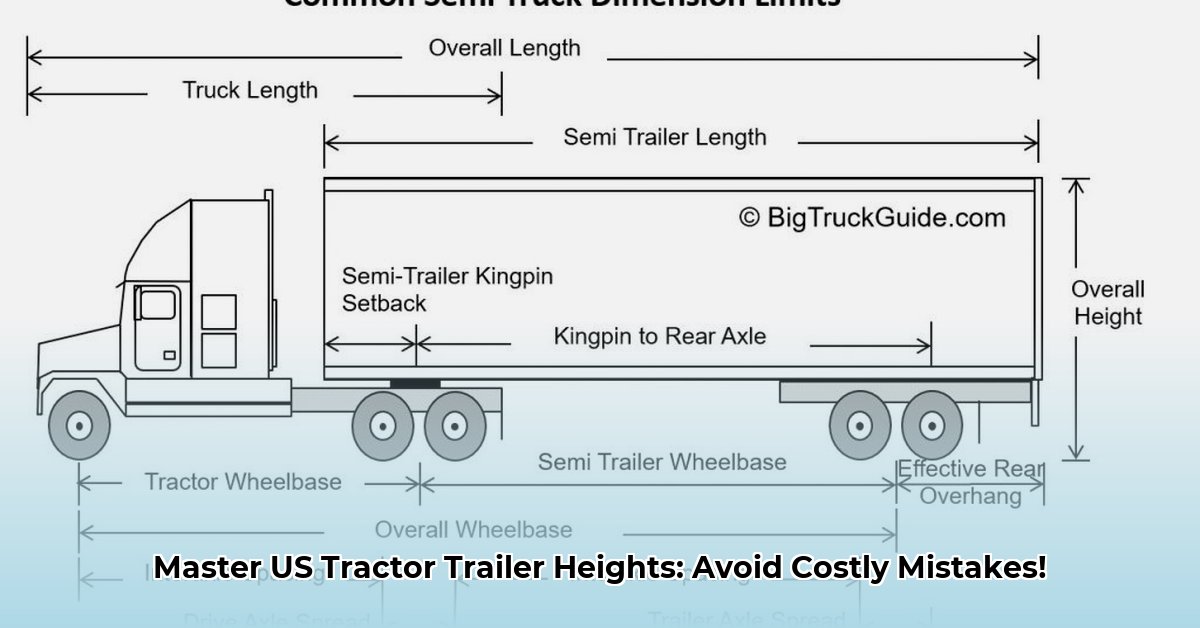
Understanding Tractor-Trailer Height Regulations
The maximum legal height for a tractor-trailer in the US is generally 13.5 feet, as set by federal regulations. However, this is just a starting point. Several factors significantly impact the overall height, potentially leading to violations and serious consequences if not properly addressed. Are you prepared to navigate the complexities of state-specific rules and various trailer types? This guide will give you the knowledge you need for compliant and safe transport. For detailed information on truck dimensions, see this helpful resource: truck dimensions.
Variable Heights: Trailer Types and Cargo
The type of trailer significantly affects the overall height. A standard dry van (a closed, box-shaped trailer) typically falls within the legal limit, while flatbeds, carrying oversized freight, or specialized lowboy trailers designed for extra-large loads, can easily exceed it. Furthermore, the cargo itself adds to the overall height. Careful measurement and understanding of both your equipment and your load are crucial for compliance.
State-Specific Regulations and Real-World Obstacles
While 13.5 feet is the federal standard, many states have stricter regulations. Low bridges, tunnels, and overhead power lines pose significant risks. Ignoring these local rules can result in substantial fines and even accidents. Understanding these variances is crucial for safe and legal operations. Consider the potential costs – fines, repairs, and delays – associated with height violations; proper planning minimizes these risks.
A Step-by-Step Guide to Safe Route Planning
Effective route planning is essential for avoiding height-related issues. Follow these steps to ensure compliance and safety:
- Precise Measurement: Accurately measure your truck's height, including the cargo. Use a reliable tape measure and account for variations depending on the load's distribution. This accuracy ensures you're not exceeding limits.
- Leverage Technology: Utilize GPS systems and route-planning software designed for trucking, which incorporate detailed height restrictions for bridges, tunnels, and other obstacles. Investing in this technology offers significant benefits in compliance and cost savings.
- Consult State Regulations: Thoroughly check each state's Department of Motor Vehicles (DMV) website for specific height restrictions along your planned route. This proactive step is crucial for avoiding violations.
- Develop Alternate Routes: Always have backup routes in place in case unforeseen height restrictions are encountered on your primary route. Flexibility is essential to adapt to unexpected circumstances and avoid delays.
Trailer Types and Height Variations
The following table outlines typical height ranges for various trailer types:
| Trailer Type | Typical Height Range (feet) | Considerations |
|---|---|---|
| Dry Van | 13 - 14 | Generally meets most legal limits; always verify locally. |
| Flatbed | Highly Variable | Cargo-dependent; frequently exceeds legal limits. |
| Lowboy/Step Deck | Relatively Low | Designed for oversized cargo; height varies significantly. |
| Refrigerated (Reefer) | 13 - 14 | Similar to dry vans; refrigeration units add weight & height. |
Consequences of Non-Compliance
Ignoring height regulations can have serious consequences:
- Property Damage: Collisions with low-hanging objects can cause significant damage to your truck and cargo.
- Personal Injury: Accidents involving height violations can lead to severe injuries or fatalities.
- Fines and Penalties: Expect hefty fines for non-compliance, impacting profitability.
- Insurance Issues: Height-related accidents may affect your insurance rates and coverage.
Proactive Measures for Height Compliance
Prioritizing safety and compliance is key. Here are some essential actions:
- Regular Inspections: Conduct routine height checks on your vehicle and cargo.
- Driver Training: Ensure drivers understand height regulations and safe driving practices.
- Route Optimization: Plan routes strategically to avoid potential hazards and height restrictions.
- Continuous Monitoring: Stay updated on changes in regulations.
By diligently following this guideline, you can significantly reduce the risks associated with tractor-trailer height and ensure legal and safe operation. Remember, thorough planning and adherence to regulations are investments in your safety and your business.